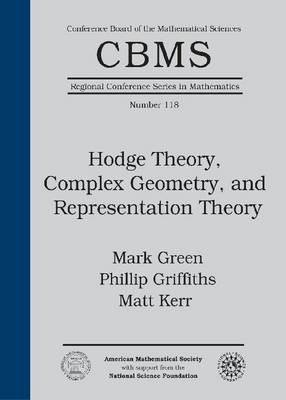CBMS Regional Conference Series in Mathematics
2 total works
An Introduction to the Theory of Special Divisors on Algebraic Curves
by Phillip Griffiths
Published 30 December 1980
In May, 1979, an NSF Regional Conference was held at the University of Georgia in Athens. The topic of the conference was 'Special divisors on algebraic curves'. This monograph gives an exposition of the elementary aspects of the theory of special divisors together with an explanation of some more advanced results that are not too technical. As such, it is intended to be an introduction to recent sources. As with most subjects, one may approach the theory of special divisors from several points of view. The one adopted here pertains to Clifford's theorem, and may be informally stated as follows: The failure of a maximally strong version of Clifford's theorem to hold imposes nontrivial conditions on the moduli of an algebraic curve.This monograph contains two sections, respectively studying special divisors using the Riemann-Roch theorem and the Jacobian variety. In the first section the author begins pretty much at ground zero, so that a reader who has only passing familiarity with Riemann surfaces or algebraic curves may be able to follow the discussion. The respective subtopics in this first section are the Riemann-Roch theorem, Clifford's theorem and the $\mu_0$-mapping, and canonical curves and the Brill-Noether matrix. In the second section he assumes a little more, although again an attempt has been made to explain, if not prove, anything. The respective subtopics are Abel's theorem, the reappearance of the Brill-Noether matrix with applications to the singularities of $W_d$ and the Kleiman-Laksov existence proof, and special linear systems in low genus.
Hodge Theory, Complex Geometry, and Representation Theory
by Mark Green, Phillip Griffiths, and Matt Kerr
Published 1 January 2014
This monograph presents topics in Hodge theory and representation theory, two of the most active and important areas in contemporary mathematics. The underlying theme is the use of complex geometry to understand the two subjects and their relationships to one another--an approach that is complementary to what is in the literature. Finite-dimensional representation theory and complex geometry enter via the concept of Hodge representations and Hodge domains. Infinite-dimensional representation theory, specifically the discrete series and their limits, enters through the realisation of these representations through complex geometry as pioneered by Schmid, and in the subsequent description of automorphic cohomology. For the latter topic, of particular importance is the recent work of Carayol that potentially introduces a new perspective in arithmetic automorphic representation theory.
The present work gives a treatment of Carayol's work, and some extensions of it, set in a general complex geometric framework. Additional subjects include a description of the relationship between limiting mixed Hodge structures and the boundary orbit structure of Hodge domains, a general treatment of the correspondence spaces that are used to construct Penrose transforms and selected other topics from the recent literature.
The present work gives a treatment of Carayol's work, and some extensions of it, set in a general complex geometric framework. Additional subjects include a description of the relationship between limiting mixed Hodge structures and the boundary orbit structure of Hodge domains, a general treatment of the correspondence spaces that are used to construct Penrose transforms and selected other topics from the recent literature.

